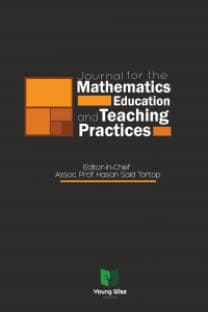The effectiveness of cognitive restructuring techniques to reduce mathematics anxiety in high school students
The effectiveness of cognitive restructuring techniques to reduce mathematics anxiety in high school students
Mathematics, Mathematics anxiety Cognitive restructuring, Students, Experiment,
___
- Abida, L., Eva, N., & Farida, I. A. (2021). The Effectiveness of Behavioral Cognitive Therapy Against Academic Anxiety. SENIKOPA National Seminar and Call for Paper for Scientists, Consultants, and Practitioners (p. 3). Malang: Faculty of Psychology, State University of Malang.
- Adetola, O. A., & Oladunmoye, E. O. (2017). Cognitive Restructuring Therapy on Reduction of Mathematics Anxiety Among Senior Secondary School Students in Two Local Government Areas of Oyo State, Nigeria. Building a Safer World Through Education, 351-374.
- Anyamene, A. N., & Ogugua, G. U. (2019). Effect of Cognitive Restructuring on Junior Secondary School Mathematics Test Anxiety in Oshimili South L.G.A of Delta State. African Journal of Multidisciplinary Research, Vol. 4(1), 158-172.
- Azwar, S. (2015). Preparation of the Psychological Scale Edition 2. Yogyakarta: Pustaka Pelajar.
- Azwar, S. (2016). Human Attitude Theory and Its Measurement. Yogyakarta: Pustaka Pelajar.
- Beck, J. S. (2011). Cognitive Behavior Therapy: Basics and Beyond, Second Edition. New York: The Guilford Press.
- Cooke, A., Cavanagh, R., Hurst, C., & L., S. (2011). Situational Effects of Mathematics Anxiety in Pre-Service Teacher Education. Hobart.
- Dowker, A., Sarkar, A., & Looi, C. Y. (2016). Mathematics Anxiety: What Have We Learned in 60 Years? Frontiers in Psychology, Volume 7, Articles 508, 1-16.
- Erfattini, I. H., Purwanto, E., & Japar, M. (2016). Cognitive-Behavior Theraphy Group Counseling with Cognitive Restructuring Techniques to Reduce Academic Procrastination. Journal of Counseling Guidance, 5(2), 119-125.
- Hadi, S., & Novaliyosi. (2019). TIMSS Indonesia (Trends in International Mathematics and Science Study). Proceedings of the National Seminar & Call For Papers (pp. 562-569). Tasikmalaya: Master of Mathematics Education Study Program, Siliwangi University.
- Hen, L., Boniel-Nissim, M., Shapira, N., & Barak, A. (2008). A Comprehensive Review and a Meta-Analysis of the Effectiveness of Internet-Based Psychotherapeutic Interventions. Journal of Technology in Human Services, 26(2), 109—160.
- Hunt, T. E., Clark-Carter, D., & Sheffeld, D. (2011). The Development and Part Validation of a U.K. Scale For Mathematics Anxiety. Journal of Psychoeducational Assessment, 29(5), 455-466.
- Luttenberg, S., Wimmer, S., & Paechter, M. (2018). Spotlight on Math Anxiety. Psychology Research and Behavior Management, 11, 311-322.
- Marliani, R. (2013). Psikologi Eksperimen. Bandung: Pusaka Setia.
- Nikmaturohmah, U. (2015). Application of Cognitive Restructuring Techniques to Improve Internal Locus of Control for Class XI Students of SMA Negeri 1 Kedunggalar. Surakarta: Universitas Sebelas Maret.
- Oktawirawan, D. H. (2020). Factors Triggering Student Anxiety in Conducting Online Learning during the Covid-19 Pandemic. Scientific Journal of Batanghari University Jambi, 20(2), 541-544.
- Park, D., Beilock, S. L., & Gerardo, R. (2014). The Role of Expressive Writing in Math Anxiety. Journal of Experimental Psychology: Applied, 20(2), 103-111.
- Ramirez, G., & Beilock, S. L. (2011). Writing About Testing Worries Boosts Exam Performance in the Classroom. Science, Volume 331, 211-213.
- Riski, F., Indiana, M., & Isna, R. (2019). The Effect of Mathematics Anxiety on Students' Problem-Solving Ability in High School. GAUSS: Jurnal Pendidikan Matematika, 2(2), 11-23.
- Saputra, P. R. (2014). Math Anxiety and How to Reduce It. Pythagoras Vol 3(2), 75-84.
- Sugiyono. (2010). Metode Penelitian Pendidikan Pendekatan Kuantitatif, kualitatif, dan R&D. Bandung: Alfabeta.
- Suhendra. (2020, Oktober 5). The Role of Students in Distance Learning. Jakarta Pusat, Jakarta, Indonesia.
- Sujarweni, V. W. (2015). SPSS untuk Penelitian. Bantul: Pustaka Baru Press.
- Syafitri, F. S. (2017). What's Up With Math Anxiety. Journal of Mathematics Education IKIP Veteran Semarang. Volume 1, No. 1, 59-65.
- Zakariya, Y. F. (2018). Development of Mathematics Anxiety Scale: Factor Analysis as a Determinant of Subcategories. Journal of Pedagogical Research, 135-144.
- Yayın Aralığı: Yılda 2 Sayı
- Başlangıç: 2020
- Yayıncı: Genç Bilge Yayıncılık
Adıtya Ananta PARAMESWARA, Sri Weni UTAMİ, Nur EVA
Role, need and benefits of mathematics in the development of society
Investigation of the effect of Go (Baduk) education on problem solving processes and thinking styles
Firuze GÜRBÜZEL, Tuğba SADAK, Atilla ÖZDEMİR
The Microsoft form as a scaffolding-based geometry learning media in online learning
Subhanudin SUBHANUDİN, A. Rasul A. RASUL, Ruben SOND, Habibi SUTİRTA
Geometric thinking levels among college of education students
